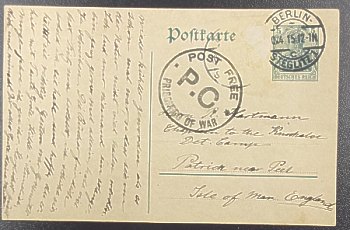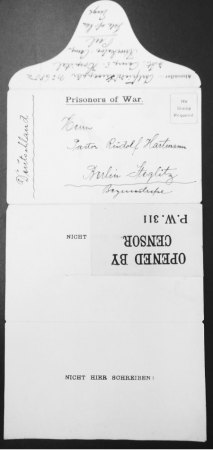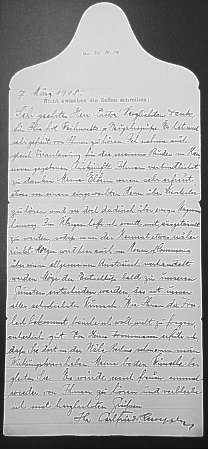
Example of incoming mail, a pre-stamped postcard, with Censor's stamp
It would appear that an original stamp has been removed - possibly by the censor
All mail, incoming and outgoing, passed through censors - mail arriving from overseas was censored in London and then transferred to Knockaloe, mail posted within the UK was apparently censored at Knockaloe - Madoc states that the first lot of centrally censored mail for Douglas camp (+ presumably Knockaloe) on 17th December 1915. There is an account by Archibald Knox which mentions checking for messages hidden under the stamp, hidden within sausages and in one case within a walnut in which the two halves had been glued back together. It would appear that parcels were thus checked at Knockaloe.
Censored mail would be indicated as such by various over-stamps - today a specialised form of philately with high prices paid for rare stamps - however collecting these censored envelopes developed from the early days as one internee at Knockaloe was willing to buy such envelopes or postcards and one camp assistant postman stole such to sell to him [see IoM Examiner 27 Nov 1915]. As mail could also be censored in the originating country there were many such possible over-stamps.

Example of incoming mail, a pre-stamped postcard, with Censor's stamp
It would appear that an original stamp has been removed - possibly by the censor
Censored incoming mail then needed to be delivered to the individual internee - there could not be a central post room open to all internees as internees in one compound were somewhat restricted in meeting internees from other compounds but especially restricted from meeting those in other camps. The arrangement adopted was well described in the evidence given in the above court case.
Each camp had a head postman with an office in his compound of the camp. The head postman attended at the censor's office to get the letters for his camp. When he got them he took them to his office in his compound for further sorting. There were assistant postmen for each compound, these varying in number. The assistant postmen attended at the camp post office and frequently assisted in the further sorting for the compounds. ... Each assistant postman, after sorting, got letters for delivery in his own compound.
Each assistant postmen had to deliver letters at the various huts. In the event of the assistant not being able to find the addressee, he had to bring them back to the camp post office for further inquiry. If after further inquiry the addressee could not be discovered, the letter was returned to the censor.
 |
The format of these letters can be seen - a single, lined sheet is available for the message on one side - this would then be folded into three. The address would written on the face - note that no stamp was required for such mail - and the sender's details writen on the flap. The unsealed folded letter was then passed to the censor. These I think are a later form - there are also similar forms but without the flap which also carry underneath the "Prisoners of War" the type "(Pat 2333/15)" The example is from my archive of letters sent to Pastor Hartman after he returned to Germany at the end of 1917. The archive is now available for research at the Manx Museum |
 |
These would appear to have been dealt with in a different manner - Schonwalder writes of seeing internees from Compound 3 (a non adjacent compound to his Compound 5) queing at the Parcels Office
|
|
||
|
|
||
| Any comments, errors
or omissions gratefully received The
Editor HTML Transcription © F.Coakley , 2019 |
||